MAINTAINING PARIS AS A WORK OF ART
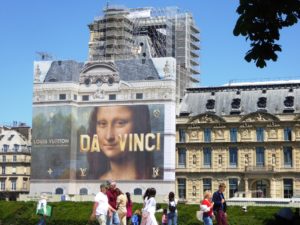
Advertisement for Louis Vuitton on the facade of the Louvre.
Paris, as a modern city with an historic heart, is above all, a work of art. As such, it must be continually refreshed to present its wonderful collection of public monuments and private buildings in the best possible light.
This requires a major commitment of funds for conservation, funding that can be difficult to allocate or generate given the many calls on the public purse.

Several years ago, the city of Venice sparked major controversy when commercial advertising was permitted on the protective hoarding or scaffolding that is necessary for any major façade cleaning or conservation project. Advertising on the Bridge of Sighs and Doges Palace was a brave move for public officials searching for ways to fund major conservation efforts.
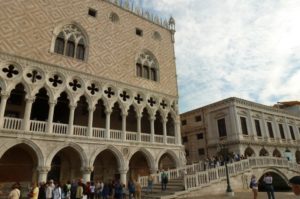
Nevertheless, the work was subsequently completed, the advertising hoarding removed, and these Venetian icons are again proudly reflecting their flamboyant historical architecture.

In Paris, the city has adopted two important strategies to keep historic buildings, both large and small, looking their best. Major public and private buildings have been permitted to include advertising on their hoardings, while the mandatory façade cleaning of private buildings is paid for by the building’s owners.
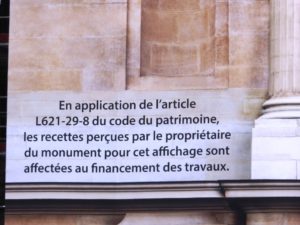
In a display of French pragmatism, a special Article of the French cultural heritage law was passed requiring all of the funds generated by such advertising to be directed to the building’s conservation works.
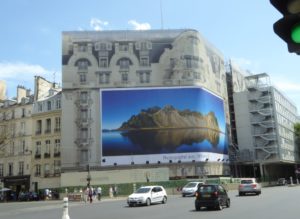
Reference to this law must be displayed on each particular advertisement such as on the famous art nouveau Hotel Lutetia at metro Sevres Babylone.
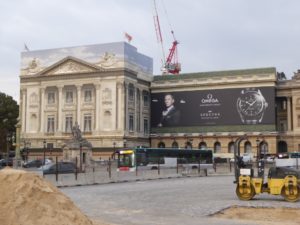
It was prominently displayed on the scaffolding for the recently completed Hotel de Crillon facing the Place de la Concorde.
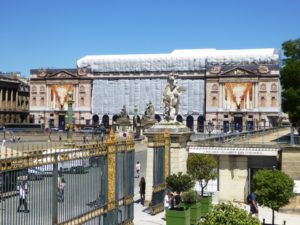
Scaffolding on the adjacent Naval Ministry building is currently adorned with advertising, while also exhibiting the glorious interior of the building.
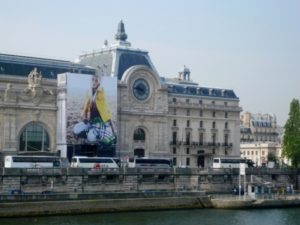
Temporary advertising has been enthusiastically embraced by many famous international brands, who vie for the honour of being associated with such prestige cultural icons such as the Musée d’Orsay and sections of the Louvre facing the Seine. Both of these works have now been completed and their full glory recaptured for public appreciation and universal admiration.
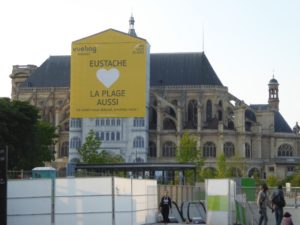
This radical policy has become so successful in mobilising funds for conservation that it has been extended to monuments such as the Bastille, Gare St Lazare and the monumental Church of the Madeleine and St Eustache.
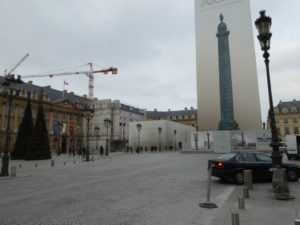
For several years, the historic column in the centre of the Place Vendôme was totally enclosed by hoarding. This work was proudly sponsored by the adjacent Ritz Hotel, which itself was undergoing total restoration. Informative signs and historic photos on the hoarding celebrated the contribution of the Hotel to the column’s conservation.
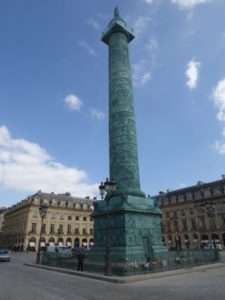
With the re-opening of the Ritz and the completion of the restoration of the column, the Place Vendôme has regained its fame as one of the best public spaces in a city blessed with many such squares.
The great boulevards and streetscapes of Paris are equally part of the identity and character of
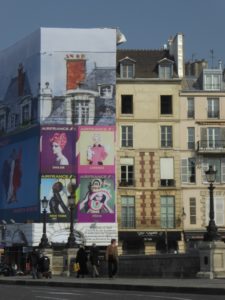
the city.
We have noticed over recent years that many of the private residential buildings undergoing façade renovations are located at prime intersections, where the visual impact of their cleaning will be maximised.
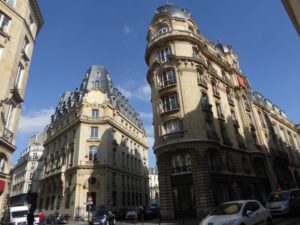
It seems to take about six months to clean the façade of the typical 19th century Haussmann-style building, although advertising on their scaffolding is not such a common sight.
Although Paris has wholeheartedly embraced this policy, other European cities including Venice and Rome, have continued to capture advertising revenue to fund their major conservation projects.
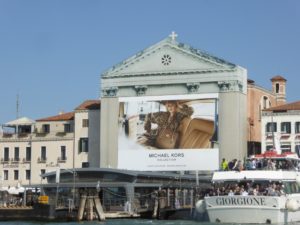
Paris has embarked on this commercially-supported conservation programme that may take decades, but the ultimate result is to protect and refresh the presentation of Paris for visitors and residents alike.
So, if you are disappointed during your next visit to Paris that one of your favourite historic buildings is covered by hoarding and advertising, take heart! When you next return, the building will be in much better condition, and once again contributing to Paris as a work of art.
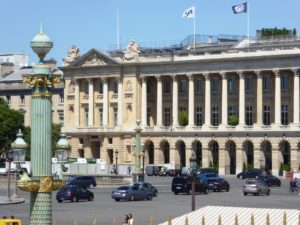


I have experienced this in Rome and elsewhere to my disappointment, but it makes sense to take the opportunity to subsidise the conservation works, as long as it is tasteful and appropriate. I can see a lot of facade cleaning taking place in cities where otherwise there is little opportunity for large scale advertising.
I presume that there is an approval process for the content of the advertising. The quality of the content is critical I think, i.e. not a new Toyota ad!
Hi Steven
I too have experienced this same disappointment and it was only when it started to become all too common that I realised something was going on. When I noticed the display of the legal requirement to devote all of the funding to the conservation work I realised there had been a real breakthrough in the funding formula adopted in Paris. This revelation came at about the same time as I was struggling with a project in Sydney that needed to fund an expensive historic facade restoration project. Our city fathers here could not bring themselves to support advertising for the length of time needed to raise the required funds.
Great observation. It does seem to make sense to raise some money in this way to help pay some of the cost of the very necessary upkeep.
Hi Tony
What really attracted us to this story is that the French devote such radical commercial creativity to the service of cultural heritage conservation.
Cheryl and Graham
The last time I was in Paris the Place de Vendome column was under radical restoration. The site, as well as the column, was/were ‘enshrouded’ by massive hoardings covered with text, repros of historic photographs, and explanations re the construction/preservation works. The jump from this approach to that of ‘hoarding as advertising opportunity’ is a fraught one. However, with stipulations in place, and indeed laws, to govern the style and visual impact of the ‘ads’ there should be zero likelihood of Steve Layman’s ‘dread’ materializing (comment above); namely, massive images of Toyotas – or Maseratis? – looming out from significant facades. Merci pour tous les image superbes, Mme. Brooks.
Hi Anna,
Yes, it does come as something of a shock at first to see all this advertising on large public buildings or historic monuments. However, as the revenue raised contributes a great proportion of the facade restoration, and is only there “for the duration”, somehow it seems acceptable–and if it must be a car company, may it be for a Maserati at the very least!